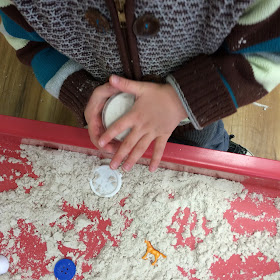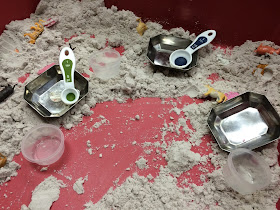I’ve written before about how the scale of art materials affects how children use them. Large paintbrushes and large paper elicit broad, wide brushstrokes, while
smaller brushes encourage smaller and more precise movements across the paper.
The same situation happens with sensory materials. Large scoops and shovels
encourage large movements – which isn’t a problem unless the teacher doesn’t
want vibrant, active movement at the sensory table. So often, teachers repeat
the refrain, “keep the sand in the table” or “it’s not okay to throw sand”,
after giving children huge shovels that naturally call for swinging sand over
shoulders and across the table. And there are the natural spills that happen
when a large bucket is filled and turned over. If the teacher wants the sand to
stay in the table, then the first step is to plan the environment and choose
materials that will make it easier for the sand to stay in the table.
In addition to helping classroom management,
for younger children, smaller scale scoops and containers can be easier to hold
and manipulate. It’s easier to fill a small container than a large one, and
easier to provide enough material in the table for all the children to be able
to fill their containers.
I set up a sensory table filled with moon sand, small plastic bowls, and measuring spoons. The measuring spoons have the added characteristic of being able to mold the sand into domes or balls. I added large plastic shapes that the children could bury in the sand, or use to fill their bowls.
Over several weeks, I changed the containers, and the objects that were hidden (or could be hidden) in the sand. The most appealing were small plastic animals, which they children covered, uncovered, and placed on top of the cakes that they molded in their containers.
The one constant as the objects changed was that they were all small. Small
enough to fit in their hands, small enough to hold a cup in one hand while
holding a spoon in another, small enough to fill up and proudly feel a sense of
accomplishment. And small enough for the children to clean their spills
independently, allowing them to take ownership over their activity, instead of
needing a teacher to manage it.







Dear Shelli,
ReplyDeleteI'm very thankful to you for sharing your blogs.
Your professional insights into children's play is extremely well documented and I'm so delighted in reading them. I'm very eager to share these documentations to enhance my teachers' professional development. Thank you!